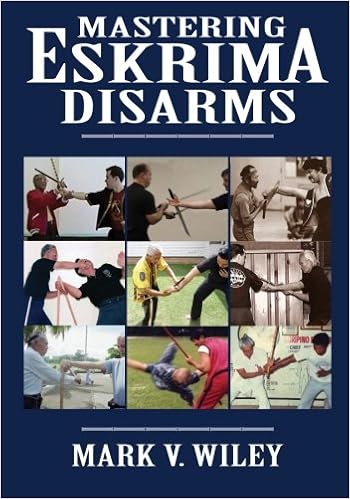Book Review --- Mastering Eskrima Disarms, by Mark V. Wiley. Tambuli Media
(Createspace). Spring House, PA. 2013. 240 pp., Paper, $29.95

If you are interested in Filipino martial arts, and
particularly the use of sticks in the Filipino martial arts, then this is a
book you should be aware of. Wiley’s goal in this book was to provide a guide
to Filipino martial arts disarms for instructors and others who wish an
in-depth knowledge of the subject. As most readers of this review will know, in
the bulk of Filipino martial arts styles, training begins with a stick or pair
of sticks. In a fight, a person with a stick has a big advantage over a person
who is unarmed and has no stick. Therefore one common tactic used in a fight
with sticks is to try and take the stick away from the opponent. In fact, in
almost any fight using weapons, if the person with the weapon can be disarmed
then their threat can be reduced. Therefore in Filipino martial arts, a great
deal of time is spent not just on training to strike and block with a stick or
other weapon, but also how to disarm one’s opponent.
This book focuses on such disarms and disarming techniques.
The book is basically divided into three sections.
In the first part, Wiley discusses what makes a good disarms
work and where and how common failures occur when someone attempts to disarm an
opponent. He discusses how one can recognize good and bad disarming techniques
that are found within various Filipino martial arts styles, and the components
of a good disarm. He also categorizes the disarms normally found in Filipino
martial arts styles by dividing them into four categories. He calls these
categories modes.
Mode One is a simple strike to the opponent, often to the
hand that holds the weapon, without using preliminary blocks.
Mode Two are techniques that involve a party with an empty
hand that is used simultaneously with a strike.
Mode Three techniques involve blocking a weapon strike with
a weapon, then redirecting the opponent’s energy, and countering.
Mode Four are techniques where a martial artist blocks his
opponent’s weapon with his own, while simultaneously using his empty hand to
trap his opponent’s weapon hand.
In the second part, Wiley demonstrates several techniques in
each mode. These are well explained through words and a series of black and white
photographs.
In the third part of the book, Wiley has collected
interesting photo sequences of several well-known Filipino martial arts masters
demonstrating the disarms they teach in their style. As many of these prominent
teachers are now deceased, this is, indeed, an important and valuable resource
for people interested in the many varieties of Filipino martial arts styles. Many
would argue that this alone is worth the price of the book.
The book is 239 pages, well-illustrated, and a valuable
addition to the library of anyone who truly wishes to understand the Filipino
martial arts in depth.
Note: Although, according to the introduction, this book was
originally set to be published by Unique Publications, a respected and
prominent martial arts publisher, that company went bankrupt before the book
could be released. Wiley went on to establish Tambuli Media, his own company,
to publish books in areas that interest him. Tambuli Media often uses
Createspace, a print-on-demand publisher, to produce the physical copies of its
books, and therefore I have seen this book listed as being published by both
Tambuli Media and Createspace.
Comments
Post a Comment